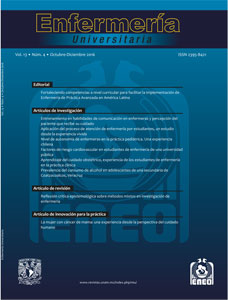Alcohol consumption prevalence among adolescents in an elementary-high school in Coatzacoalcos, Veracruz
Main Article Content
Abstract
Objective: To estimate the prevalence of alcohol consumption among students in an elementary-high school in Coatzacoalcos, Veracruz.
Method: This is a descriptive and transversal study with a sample of 248 adolescents who were selected by stratified probabilistic sampling by sex and school grade. The Alcohol Use Disorders Identification Test (AUDIT) was used.
Results: The mean age of the participants was 13.5 years old. Forty three point one percent of the participants’ parents also consume alcoholic beverages. The mean starting alcohol consumption age is 11.5 years old. The average number of alcoholic beverages consumed at a time was 3.1. Preferred drinking places were parties (26.6%) and family gatherings (25.4%). Regarding consumption, 79.6% present a low risk pattern, 18.5% present a high risk pattern, and 1.9% of the participants show a very hazardous pattern. There was a correlation between drinking students and drinking parents.
Conclusions: Students are starting to drink at younger ages and this is seemingly accepted by the family, a situation which increases the damage and addictive behaviors among students. Considering all of this, the nursing professional has the task to address this problem through diverse preventive measures, as well as interventions aimed at reducing the consumption of alcohol among young students.
Publication Facts
Reviewer profiles N/A
Author statements
- Academic society
- N/A
- Publisher
- Universidad Nacional Autónoma de México
Article Details
Dimensions citation
MÉTRICAS
Enfermería Universitaria by Universidad Nacional Autónoma de México it is distributed under the License Creative Commons Attribution - NonCommercial - NoDerivatives 4.0 International
Accepted and published articles become open-access under the terms of the Creative Commons CC BY-NC-ND 4.0 license, which authorizes the reproduction and sharing without commercial purposes, provided the corresponding acknowledgments to their authors. Authors are allowed to manage a self-archive copy of the article’s published version so that they can open-access it in their personal or institutional web pages, and/or any other broad-diffusion space.



